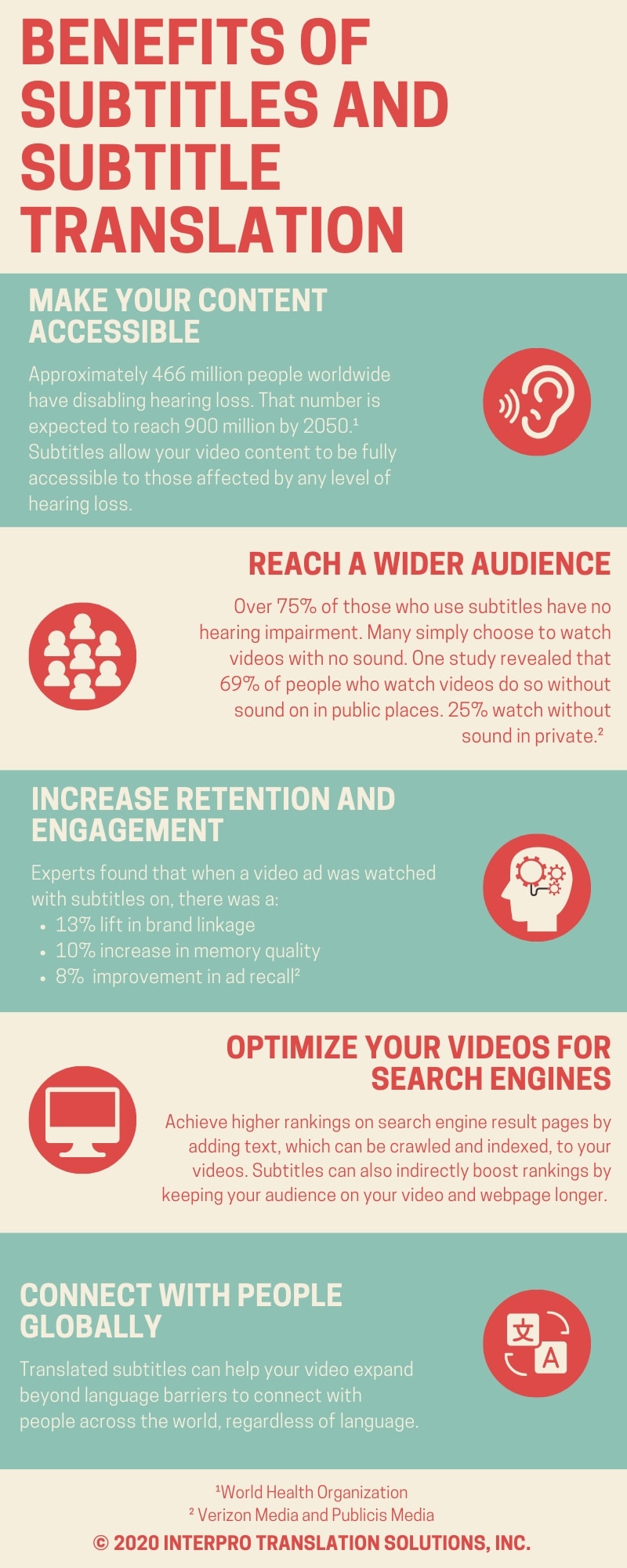
Videos are an incredibly effective vehicle for delivering information to your audience. A 2020 report by Wyzowl revealed that people are watching more video now than ever before. By itself, it’s an effective medium, but there is something that makes video even more far-reaching, engaging, and accessible – subtitles. Source-to-source subtitling and subtitle translation ensures that video content can be understood by everyone, regardless of the original language or whether or not the audio is being played.
If you are curious about what is involved in subtitle translation, read on to learn more about how beneficial they are, how translating them can help your business, and how to ensure the job is done right.
What are subtitles?

You very likely come across subtitles at some point in your day-to-day life. You may even be among the growing group of people who watch everything with subtitles turned on. Subtitles are the on-screen text that displays the dialogue, voice-over, or audio commentary of a video. This text-based supplement is a cost-effective solution that helps people around the world understand and process on-screen content.
Uses for subtitles
Subtitles aren’t just for foreign language television shows and movies. They can be placed on just about any type of video, including:
- Video ads on social media
- eLearning content
- Organizational training videos
- Instructional and how-to videos
- Music videos
If it’s a moving image with audio, it can likely be enhanced by including subtitles.
Advantages of adding subtitles
Why go through the effort of including subtitles with your video? Let’s explore some of the most important benefits.
Reach More People
According to the World Health Organization, around 466 million people worldwide have disabling hearing loss. Subtitles make your content accessible to those who may not be able to clearly hear the audio.
Subtitles aren’t just about making videos accessible to those with hearing disabilities: they make the medium more accessible to everyone. In fact, a 2019 study by Verizon Media and Publicis Media reported that 80% of people who use captions aren’t deaf or hard of hearing.
That’s because in today’s multitasking and mobile society, not everyone watches videos with the audio turned on. The Verizon Media study showed that 69% of people view videos without sound when in public places, and 25% view video without sound in private. A staggering 80% said that they are more likely to watch an entire video when captions are available.
By subtitling your video, you tap into an entire audience of viewers who prefer watching over listening when online.
Improve retention and engagement
Subtitles are an excellent way to make video content more engaging and informative, especially in the eLearning space. Having another medium to convey the information at hand can lead to higher retention rates over a longer period of time.
The same theory applies to video marketing. In the Verizon Media study, experts found that there was an 8% improvement in ad recall, a 10% increase in ad memory quality, and a 13% boost in brand linkage when captioning was utilized.
SEO: Search Engine Optimization
If you want your website to rank higher on Google’s search engine result pages, subtitling can help you do that too, directly and indirectly. Since Google’s algorithm can’t yet process audio or video, the transcript of subtitles allows search engines to crawl and index your video content. A higher ranking on Google leads to more website traffic, which results in increased conversions and sales.
Google also takes note of how long visitors stay on a webpage, rewarding those who keep the attention of their audience for a longer period of time. Because subtitles can increase the time a person watches a video, it indirectly impacts SEO.
However, adding subtitles isn’t enough to connect with your audiences if they can’t understand the language the subtitles are written in. This is where subtitle translation becomes important.
Subtitle translation
Subtitle translation is the process of translating a video’s audio script to another language. Videos can be subtitled in any language, giving audiences the opportunity to watch and understand, even if the spoken audio is in a different language.
Take all the benefits of source language-to-source language subtitles, and add to that the ability to connect with a multilingual audience. This is how subtitle translation significantly enhances the reach of your video content. Translated subtitles allow your video content to be understood by anyone, regardless of the language spoken in the video.
Voice-over recording is another effective video translation option, but isn’t always feasible. Sometimes, organizations opt not to use voice-over because of the increased costs as compared to subtitles. Other times, it simply doesn’t make sense depending on the type of video, such as music videos. Subtitle translation is the perfect solution in these situations.
How subtitle translation works
Although subtitles are text-based, the process isn’t as simple as replacing existing words with their translation. To get a better understanding of how subtitle translation works, it’s important to know something about subtitle formats.
Subtitle formats
Subtitles can be open or closed captioned. Open captions are integrated within the video itself, and cannot be removed or changed without modifying the source video. These are often called “burned” captions, because it is like they are burned onto the moving image.
Closed captions on the other hand, give the viewer the option to turn them on or off. Closed captions can be created with different file formats, including SRT and WebVTT.
SRT translation
This text file format stands for SubRip Subtitle. SRT is the most common subtitle file format, and consists of four components:
- an order number
- the time that the subtitle appears
- the caption and
- a blank line indicating the end of a subtitle.
Using SRT is advantageous, because it is supported on a wide variety of platforms. However, it lacks control over certain features included with the WebVTT format.
WebVTT translation
VTT or WebVTT stands for Web Video Text Tracks. This format was modeled after – and is similar to – SRT. Although they share many of the same features, WebVTT is a more robust solution, giving developers options when it comes to subtitle placement, font, color, and format. WebVTT also contains metadata that isn’t displayed on-screen, but contains information about authors, dates, instructions, and more.
Subtitle translation process
No matter which type of text file is used, the subtitle translation process can be broken down into seven general steps.
- Script transcription: If there is no script available, the audio will first need to be transcribed.
- Subtitling: The transcribed script is time-coded and formatted for VTT or SRT.
- Translation, editing, and proofreading: Once the transcribed text is available, translation can begin. This process includes the editing, proofreading, and quality assurance of the transcribed content.
- Translated script approval: Once the translation process is completed, the deliverable is sent to the client for final approval.
- Sync text with audio: Translated text is synced with the source audio so that dialogue and on-screen visuals are harmonized.
- Translated video validation: The final product will be reviewed by a native speaker for clarity, accuracy, formatting, and functionality.
- Deliver target language video: The subtitled video and/or subtitle files are delivered to the client ready for use.
Ensuring High-Quality Translations
If you’re considering adding subtitles to your video, hiring a professional translation company is the best way to ensure a high-quality translated product. Not only do language professionals accurately translate the material, but they also take special care to localize the content. This means that all text will be culturally appropriate and formatted correctly, making it easily read and understood at a normal speed without detracting from the visuals on the screen.
Professional translation services go through a multi-step process that includes quality control checks by native speakers throughout the workflow. They are aware of the challenges and obstacles commonly encountered with subtitle translations, such as text display issues, and know-how to resolve them.
Conclusion
Subtitles are a helpful tool that allows your videos to effectively reach a larger audience. Subtitle translation takes that a step further, expanding your reach to those who speak other languages. When done by a professional translation company, high-quality subtitle translations can help make your video content accessible to all.
Category: Translation
Tags: SRT, SRT Translation, Subtitle, Subtitle Translation, Subtitles, Subtitling, VTT, VTT Translation, WebVTT, Webvtt Translation
Service: Video Translation
Industry: Audio and Video Translation, E-Commerce, Education, Healthcare and Medical, Learning and Development, Manufacturing, Software, Travel and Hospitality
Don't forget to share this post!
Stay Updated with Interpro
Subscribe to our newsletter for the latest updates and insights in translation and localization.








